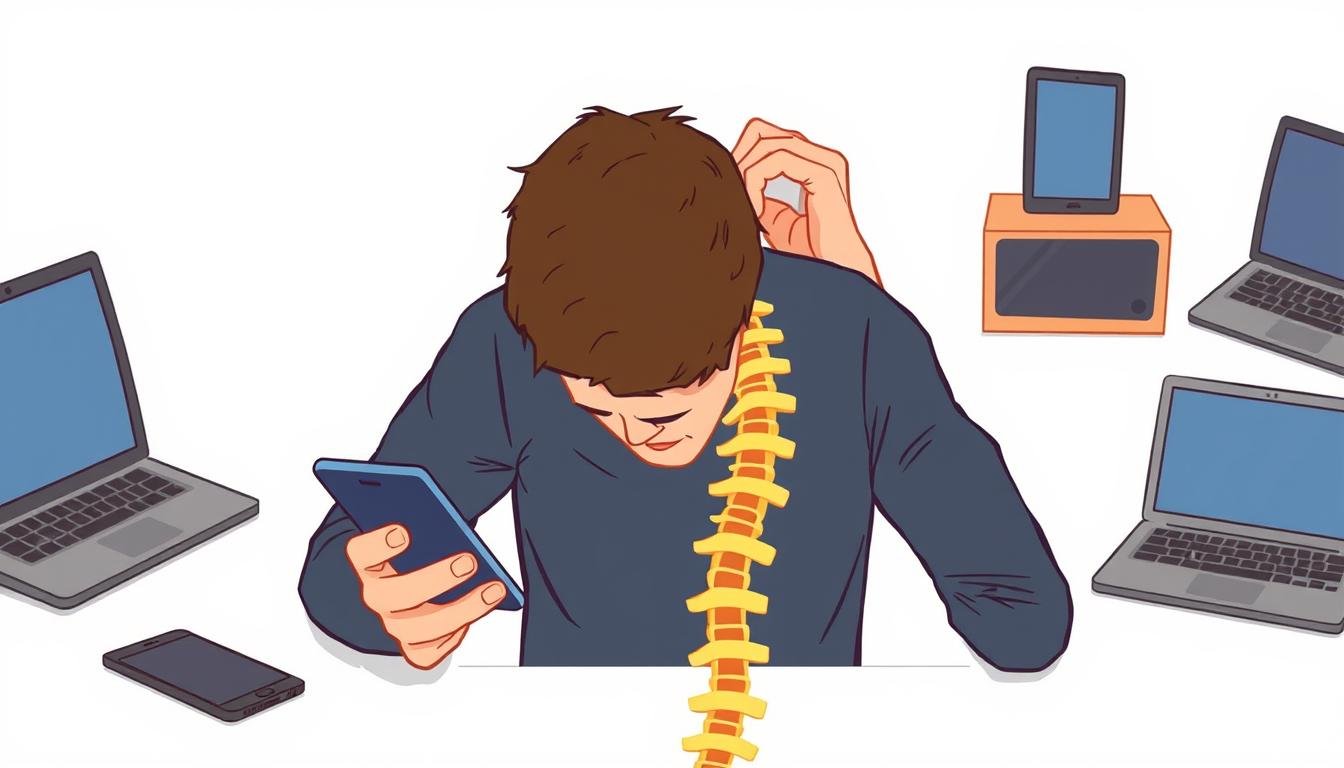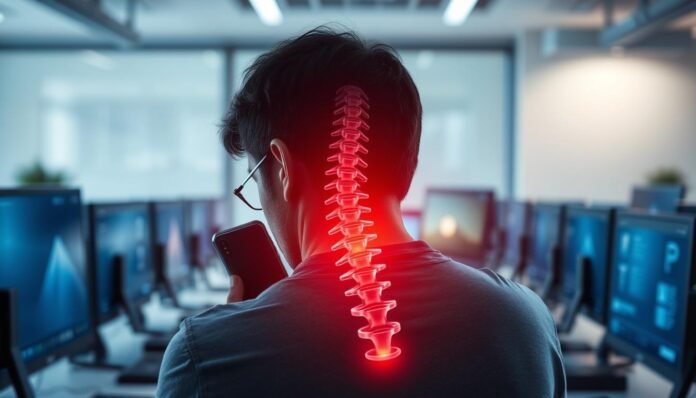In today’s world, many people suffer from tech neck, which is caused by too much screen time. It’s important to know about tech neck to stay healthy.
A person hunched over a smartphone, with visible strain on their neck and shoulders, in a modern office setting surrounded by digital devices, blue light emanating from screens, a silhouette of a spine illustrating misalignment, and soft lighting to emphasize discomfort.
Knowing about tech neck helps us avoid its problems. By understanding its causes, we can take steps to stay healthy. This knowledge is key to protecting our health.
What is Tech Neck?
Tech neck is when your neck and spine hurt from looking down at screens. It’s common today because we often use phones, tablets, and laptops. If not fixed, it can cause pain and damage.
Using digital devices frequently is why tech neck occurs. It’s important to know the risks and how to avoid them. This will keep our necks and spines healthy.
Knowing what tech neck is helps us deal with it. We can prevent it by being careful with our posture and taking breaks. Doing exercises that strengthen our neck and spine also helps.
Causes of Tech Neck
Understanding tech neck and its causes is key. Poor posture and bad ergonomics when using devices are big reasons—spending hours hunched over phones, tablets, or laptops strains our neck muscles.
The weight of these devices, though small, can cause neck pain. Extended screen time makes the problem worse. We often forget to stretch while scrolling, watching videos, or working.
This can make our necks stiff and sore. Knowing these habits and trying to improve our posture helps. Taking breaks to stretch also helps.
It’s essential to know how our daily habits affect our bodies. By understanding the causes of tech neck, we can start to prevent and relieve it. Simple changes, like adjusting screen heights or stretching, can significantly help.
Being aware of our device use and taking steps to improve posture helps. By knowing the causes and making small changes, we can have a healthier relationship with our devices.
Symptoms of Tech Neck
Understanding tech neck is key. Looking at screens for too long can hurt and stiffen your neck.
Headaches and eye strain are also common. These problems result from looking at screens all day. It’s hard to move your neck when you have a tech neck.
If you have neck pain or stiffness, it might be tech neck. Catching it early can prevent further pain. Knowing the signs is essential.
Listen to your body for signs of tech neck. Knowing the symptoms can help you avoid them. Check your daily habits to see if you’re at risk.
Risk Factors for Developing Tech Neck
Knowing about tech neck and its risks is key to avoiding it. Many things, including age, can make you more likely to get tech neck. Both young and old people can get it but for different reasons.
Young people often use phones a lot. They sit poorly while using devices. This can lead to tech neck.
How you live can also play a part. Sitting a lot in front of computers or TVs is bad. Jobs that require sitting or using devices a lot also raise the risk. Office workers, gamers, and programmers are at higher risk because of their jobs.
An illustration of a person hunched over a smartphone, showing a distorted spine and neck angle, surrounded by digital devices like laptops and tablets, emphasizing the strain on the neck and shoulders, depicted in a slightly exaggerated, cartoonish style for clarity.
Knowing the risks helps you prevent tech neck. By understanding it, you can take steps to lower your risk. This includes taking breaks, exercising, and keeping good posture.
This knowledge helps you make better choices. It can reduce your chance of getting tech neck.
How to Prevent Tech Neck
Knowing what tech neck is helps us take steps to prevent it. We need to be careful about how we sit when using devices. Keeping our neck and spine straight is essential.
Setting up an ergonomic workspace is a good start. This means adjusting our chairs, monitors, and keyboards for better posture. It helps a lot.
It’s also important to take breaks often. Short walks or stretches every hour can help. These actions reduce neck and spine strain.
We can avoid tech neck by being proactive. Simple steps like good posture and breaks are key. They help us stay healthy and pain-free.
Making a neck-friendly workspace is simple. An ergonomic chair and monitor at eye level help a lot. Keeping keyboards and mice close also helps. Remember, being mindful and taking breaks is essential.

Techniques for Relief
Knowing what tech neck is helps us find ways to feel better. Simple exercises can help a lot. Neck stretches like the chin tuck and ear-to-shoulder can be done anywhere.
Doing these stretches helps loosen tight muscles and improves how we stand. Muscle strengthening exercises are also key. They allow the neck and upper back to stay strong.
Exercises like shoulder rolls, neck bridges, and scapular squeezes are good. They help us carry our heads better and reduce strain from screens.
Mindfulness, like meditation and deep breathing, also helps. It reduces tension and helps us stand better. Being mindful and stretching often can lower the chance of tech neck.
Remember, small steps can lead to significant changes. They help us feel better and live healthier.
Treatment Options for Tech Neck
Many treatments are available for tech neck. Knowing what tech neck is and why it happens helps find the right help. Physical therapy is a common choice. It includes exercises and manual techniques to ease pain.
Chiropractic adjustments are also helpful. They align the spine and ease muscle pressure, which can relieve pain and discomfort. A chiropractor will create a treatment plan just for you.
Other options like acupuncture or massage can also help. They promote well-being. If symptoms don’t get better, seeing a healthcare professional is key.
They can determine the best treatment for you and teach you how to avoid tech neck in the future. Understanding tech neck and its treatments is the first step to a healthier life.
Long-Term Solutions
It’s important to know about tech neck and how it affects us. By being aware, we can manage and prevent it. Setting limits on screen time and using voice-to-text helps a lot.
Seeing a doctor regularly is also key. They can help us stay healthy. Knowing about ergonomic tips and new tech can guide us.
Being careful with our tech use is a big step. This way, we can avoid tech neck. It’s all about being savvy with our devices.
We should all care about neck health. By being intelligent and aware, we can make a better future. Let’s work together for a healthier world.
Conclusion: Taking Action Against Tech Neck
In today’s world, knowing about tech neck is key. We’ve discussed what it is, its signs, and how to avoid it. We’ve also looked at ways to fix it.
To fight tech neck, we need to watch our posture and habits. Simple changes like keeping screens at eye level help a lot, as do taking breaks and doing neck exercises.
By acting now, we can feel better and live better. Let’s take care of our necks. This way, we can stay strong and pain-free in our digital lives.
FAQ
What is tech neck?
Tech neck is when you feel pain in your neck and back from using devices too much. This happens because of bad posture and too much screen time.
What are the common causes of tech neck?
Tech neck comes from bad posture and spending too long looking at screens. The weight of devices also puts strain on your neck.
What are the symptoms of tech neck?
Signs of tech neck include neck pain and stiffness. You might also have headaches, shoulder pain, and eye strain. These get worse with more screen time and bad posture.
Who is at risk of developing tech neck?
Anyone can get tech neck, but it’s more common in people who use devices. This includes those who sit or work on computers or phones a lot.
How can I prevent tech neck?
To avoid tech neck, maintain good posture when using devices. Take breaks and use ergonomic tools. Exercise can also help.
What are some techniques for relieving tech neck symptoms?
To feel better, try stretching and strengthening exercises. Mindfulness can also help. These can ease pain and improve movement.
When should I seek professional treatment for tech neck?
See a doctor if your tech neck doesn’t get better or gets worse. They can help with physical therapy or chiropractic care. This can fix the problem and help you manage it better.
What are some long-term solutions for managing tech neck?
To manage tech neck long-term, change how you use technology. Set limits and use voice-to-text. Also, see doctors regularly and learn about new ergonomic tools.
You may also read: What Does a Radiology Tech Do?
